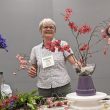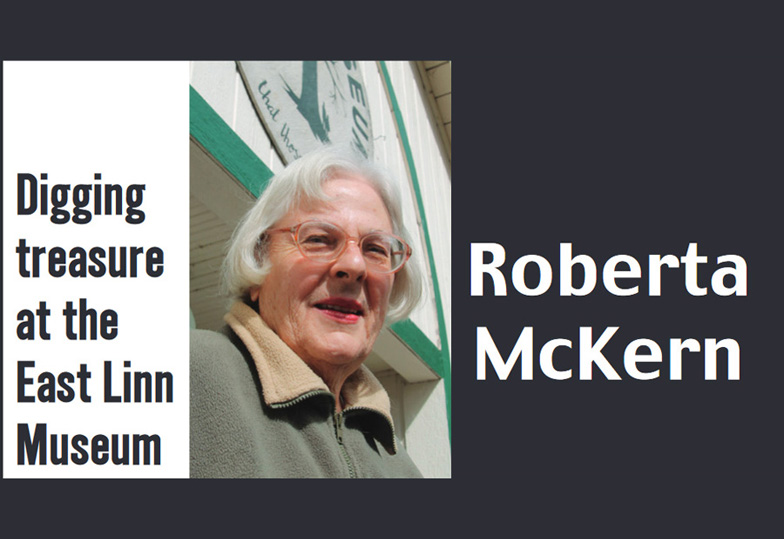By Roberta McKern
East Linn Museum historian and columnist for The New Era
At this time of year, as summer begins to wane, some of us are lucky enough to be able to visit scented backyards, where perfumes set forth by blooming honeysuckle, privet hedge, butterfly bush and rose waft and mingle on passing breezes. “Ah, the country garden,” we might think.
Then we might begin to ponder, “Is this how it really smelled in the past?”
Nothing strikes us as more fleeting than the scents of history. That’s just as well when it comes to tales of carnage and destruction. Then the scholar who observes, “History stinks,” would be too right.
On the other hand, taking East Linn Museum artifacts into account, how familiar would the scents, aromas and stenches of the quotidian past seem to us?
Most things we sniff, whiff or smell are momentary. Therefore, we will have to surmise how it once was more than 100 years ago when, for example, Sweet Home was a small community of between 150 and 180 souls.
The main part of town stretched to the east from what had been Buckhead, where Long Street crossed a bridge over Ames Creek to include Mossville at its far end. Houses often had gardens and barns, hen houses and pig sties, not to mention privies. Farmland surrounded most of the town. There was some logging on the ridges beyond Sweet Home valley, but conifers shrouded them, mostly.
This was important. Likely all of the houses came from logs and lumber cut and milled locally. In addition, each house relied on wood as fuel for stoves and fireplaces, the basic warmth of survival in a temperate and, in wintertime often intemperate, climate.
Also, all roads leading into the town were made of mud. Horses, mules and oxen provided transportation, in addition to walking. The first two animals could be ridden, but oxen pulled wagons. And their byproducts heightened the mud’s varying odors.

When we think of the prevalence of privies, a certain pall might hang over the town, especially near the livery stable at the south, where Old Holley Road now connects to the area. We assume that, like households with barns and cows and horses, the livery stable maintained a manure pile. Experience says good piles made for excellent potato patches next to the barn, giving meaning to the derisive phrase, “B.S. and potato peelings.” For many of us who do not live on farms, the familiarity of these piles has passed us by.
On the other hand, we still encounter privies in some of the back-to-nature parks where bits of forest can be visited.
Sweet Home earned the name “Privy City” in the early 1930s, but when the expansion of logging caused rapid growth, the town ran out of more convenient housing with better indoor plumbing. In fact, many earlier housing plans for “cottages” don’t even include it. The outdoor well and pump and system remained an accepted standard in many places well into the 20th century.
So did family- and livery-stable-owned manure piles plus privies hang a certain pall over the town? For a dog’s sense of smell, it certainly would. But we humans might not have noticed so much because, for one thing, we’d be smelling smoke from many household fires.
To add to the mix, a tannery and furniture manufacturing plant existed for a while to the north of Long Street on Ames Creek. And there were hopes for floral scents from country gardens.
Elaborate plans for genteel privies used to call for concealing their purposes by making them look like garden sheds on the side toward the house.
Vining plants and flowers meant to complete the illusion could also add scents like those of honeysuckle and roses. Gentility believed in tackling smells. (An open bottle of pine-scented Air Wick freshener was once spied in a privy – an act of futility, it was still determined.)
As we move into the East Linn Museum’s household room displays, we come into contact with gentility starting with the parlor and its potential smells.
Actually, in the late 1800s, a parlor acted as a luxury. It represented a householder’s ability to afford unused space and was mainly used to entertain company among a setting of showy objects representing good taste. Plus, it sat away from other rooms and smells of a family’s general activities.
As such, how might a parlor smell? The cylindrical Hottentot stove in the museum’s parlor and the various lamps, such as those on the organ, provide one answer. It smelled like a wood-burning stove and kerosene from the lamps. Depending on the guests, it might also smell of pipe tobacco, but hopefully not of chewed tobacco, despite the presence of a spittoon.
What it should not have smelled like was boiled cabbage, frying fish or other unpleasant cooking odors. It seems as if in the times of Victorian snobbery, boiled cabbage in particular signified the lower classes, cabbage being a cheap food. It was also the source of even worse-smelling sauerkraut when chopped up, salted and fermented.
At any rate, many parlors likely had a musty, closed-up air, especially when decorated with such artistic works as dried cattail reeds, their velvety seed heads painted in bright colors like red, blue, green and violet, all stuffed into a rustic umbrella stand. But the museum lacks such an aesthetic endeavor.
Next to the parlor, however, the museum kitchen represents the source of many household smells.
Here we associate good aromas of baking bread, especially as cinnamon rolls and all of those aromas of breakfast, lunch and dinner we like best to recall.
Yet, looking at old cookbooks, we find we have to hold on to the idea of plain country living with salt, pepper and vinegar being primary ingredients when seasoning meat, potatoes and salads. No oregano, for example, and garlic shows up primarily in dill pickles. Still, spices like cinnamon and allspice are plentiful, and when it comes to nutmeg, those on display at the museum still hold their scent, the nuts being whole for hand-grinding.
Olive oil and butter often served as fat for earlier recipes, but we can remember when the scent of bacon pervaded kitchens, its drippings collected for frying just about anything, chicken and beef steak, in particular.
The smell of coffee, too, pervaded the kitchen, in keeping with the aroma arising when coffee mills were used to grind the beans. The museum’s kitchen displays several coffee mills.

For many families, kitchens were the heart of the house. For one thing, with the big cast-iron stoves burning through armfuls of split wood hauled from the woodshed, they were the warmest places to be. This might seem unwelcome in the summer, when canning season came around at the peak of weather, but it wasn’t regretted during colder months.
Kitchens, too, signified good things to eat, including sweet dishes containing sugar and vanilla or lemon extract.
Those two extracts are the ones primarily mentioned in a Sears Roebuck catalog from 1896, echoing the “White House Cook Book” of the same era. However, the catalog enumerates many more available extracts, among them ones for gin and whiskey. So a lady ordering such extracts did not have to visit the Buckhead Saloon to achieve those flavors. She would never visit a saloon, anyway, but likely she could smell the scents of alcoholic beverages when passing by the Buckhead and also of the tobacco that men smoked in pipes, as a cigar or cigarillo, or as a roll-it-yourself cigarette. Or, they might have been chewing or sniffing it as snuff, according to a museum display. (The tobacco is stored in a closed cabinet, so we can’t say if the samples still maintain their aroma.)
Spittoons aren’t as favored as they once were, but one shows up in the museum kitchen. Perhaps Dad took an after-dinner chaw.
But regarding better hygiene, the kitchen and its warmth also served as a bath house on Saturday nights, and the laundry room when intemperate weather prevented washing in the backyard with a bonfire under the big iron kettle or, better, on the back porch, with a teenaged boy operating a rocked tub like the one in the museum’s washer section.
Bodies and clothes both were cleaned with unscented lye soap, although scented soaps like Colgate’s “Cashmere Bouquet” could be ordered from Sears.
The “White House Cook Book” offers recipes for shampoo and pomade, too. The shampoo calls for olive oil, borax and boiling water. (If this is a little extreme, just rub some olive oil into the hair.) The pomade involved rendering out the fat from a marrow bone, mixing that with half a pint of oil (olive?) and “10 cents'” worth of citronella. Maybe that and slicking the hair kept mosquitoes at bay.
We can keep aromatics in mind as we move into the museum’s bedroom, where a pretty girl and any sensitive woman would like to display bottles of toilet water and other perfumes on her dresser, emulated by bottles on the one in the museum.
We can link the kitchen and bedroom in a sense when we think of the stereotyped country girl who douses herself in vanilla to smell good. Lemon extract, it seems, wouldn’t do. Such a girl might also chew red flannel to redden her lips, or rub her cheeks with the dampened cloth to dye them a little rosy.
The 1890s catalog offers a myriad of scents, some of them like those of the extracts unexpected. Take Frangipani, Ylang Ylang, Jockey Club, Shandon Bells and Musk, tonquin, for example.
A real surprise is New Mown Hay. The catalogs sometimes astound. Ward’s also sold a hunter’s disguise: a straw suit which let them resemble a haystack. Add the scent of New Mown Hay from the perfumes and they could surely confuse their prey, likely geese and ducks.
Along with articles of perfumery, other prominent bedroom items include a chamber mug and lidded slop jar near the bed, which match a basin and large pitcher set on a commode. The latter served as a bathroom, so to speak. Its cupboard concealed a chamber pot, slop jar and odors made by their use during the night.
In addition, it had a drawer for toilette needs, plus a rack for a towel to be hung behind the basin and pitcher. If you placed a mirror on the wall and brought some warm water in, Father could also shave there with the basin, although he’d likely prefer to do it in the kitchen near the stove’s heat.

After all, in general, the kitchen was where Saturday-night bathing and all kinds of washing up took place.
The remedies, potions, patent medicines and nostrums favored as cure-alls by family members also could likely be found there as well. There were liniments for aches and pains and elixirs to treat dyspepsia and debilities real or imagined, like Dr. Parmenter’s Magnetic Oil, Mustang Liniment and Kickapoo Sargwa for the relief of biliousness, constipation and sluggish liver. Some are represented in the museum’s doctor’s office, but they’re locked up, so we can’t sample their smell.
Too, the pervasive odor of scorched food lingering throughout the house as well as in the kitchen spoke to visitors of a bad cook.
None of the scents in Ward’s and Sears matched those of honeysuckle, privet, butterfly bush and roses, which led to the pondering of how things smelled in the past inspired by artifacts at the East Linn Museum.
Perhaps old-fashioned gardens abounded around houses in the late 1890s and wafted out scents of blooming shrubs and fallen ripe fruit fermenting under apple and pear trees. And maybe the drifting smell of wood smoke from the various houses and businesses signaled a welcome to approaching travelers.
We can only guess how it was. Many smells are but a moment long, and that is certainly a good thing.
We at the museum wish to thank all who contributed to the success of the annual yard sale, especially the ones who remained to help it run smoothly and to clean up. The usual plea goes out. We need more volunteers to keep the museum going. For the older regular ones, the sale proved pretty overwhelming and we were reminded we are just that: old, over 80. So please consider a future for the museum and volunteer. You will be welcomed!





